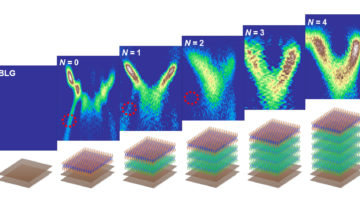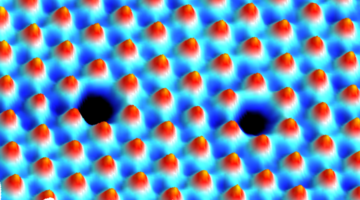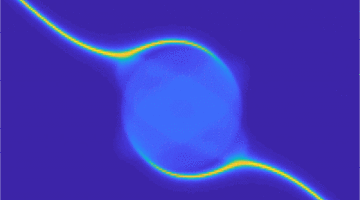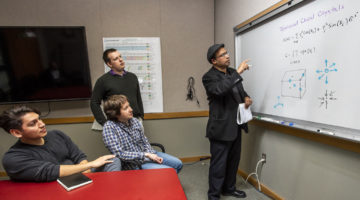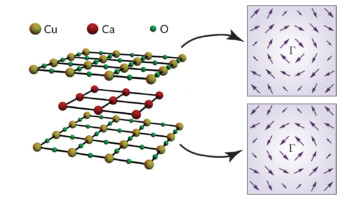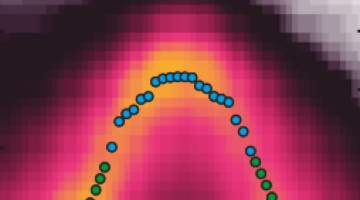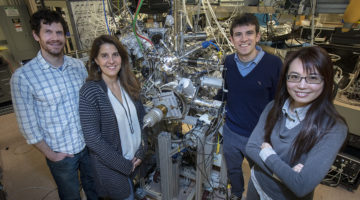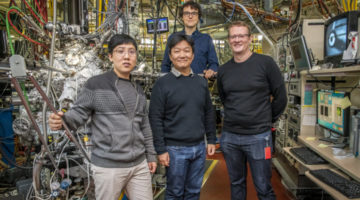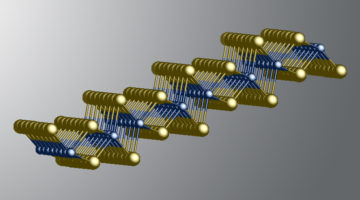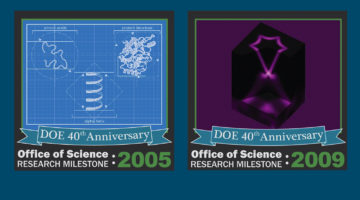ALS studies highlighted interactions that can occur between technologically intriguing 2D materials and the substrates that physically support them. The results provide important insights into the issue of non-negligible interlayer coupling and demonstrate the potential for tuning single-layer properties through substrate engineering. Read more »
The Beauty of Imperfections: Linking Atomic Defects to 2D Materials’ Electronic Properties
Two studies reveal surprising details on how some atomic defects emerge in transition metal dichalcogenides (TMDs), and how those defects shape the material’s electronic properties. The findings could provide a more platform for designing 2D materials for quantum information science and smaller, more powerful optoelectronics. Read more »
Chiral Crystals Give Rise to Topological Conductors
Researchers have discovered materials whose chiral crystal structures produce chirality in their electronic behavior. These topological conductors retain their unique electronic properties regardless of defects and open new possibilities in materials research. Read more »
The Best Topological Conductor Yet: Spiraling Crystal Is the Key to Exotic Discovery
Researchers have discovered the strongest topological conductor yet, in the form of thin crystal samples that have a spiral-staircase structure. The realization of so-called topological materials—which exhibit exotic, defect-resistant properties and are expected to have applications in electronics, optics, quantum computing, and other fields—has opened up a new realm in materials discovery. Read more »
Spin-Momentum Locking in Cuprate High-Temperature Superconductors
A form of spin-momentum locking, similar to the strong linkage between electron spin and momentum in topological insulators, has been found in a cuprate superconductor. The results open a new chapter in the mystery of high-temperature superconductors, suggesting that new, unexplored interactions and mechanisms might be at play. Read more »![]()
![]()
Electric-Field Switching of Topological Phase
Researchers have successfully switched a topological insulator on and off by applying an electrical field. The work represents a major advancement toward the creation of a functioning topological transistor that would allow devices to operate more efficiently at lower power than conventional electronics. Read more »![]()
![]()
Revealing Hidden Spin: Unlocking New Paths Toward High-Temperature Superconductors
Researchers used spin- and angle-resolved photoemission spectroscopy (SARPES) to uncover a distinct pattern of electron spins within high-temperature cuprate superconductors. The discovery provides new insight into materials with potential for super-efficient power transmission without any loss of electron momentum. Read more »
Topological Matters: Toward a New Kind of Transistor
An experiment has demonstrated, for the first time, electronic switching in an exotic, ultrathin material that can carry a charge with nearly zero loss at room temperature. The ease in switching the material from an electrically conducting state to an insulating, or non-conducting state, bodes well for its future transistor applications. Read more »
Researchers Confirm New 2D Topolgical Insulator
Researchers have established that a particularly stable form of WTe2 is a two-dimensional topological insulator, confirming recent predictions. The findings should provide new opportunities for fundamental studies of topological phenomena and for next-generation spintronic applications. Read more »![]()
![]()
ALS Work Highlighted in DOE Top 40 Countdown
To celebrate DOE’s 40th anniversary (October 1, 2017), the Office of Science (SC) collected 40 scientific milestones from the previous 40 years, each one supported by SC. The ALS played a key role in two of the milestones: 2005 (ribosome) and 2009 (topological materials). Read more »
